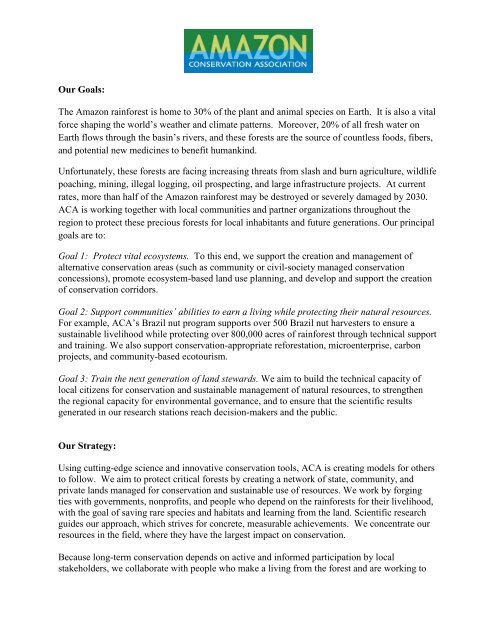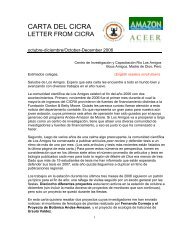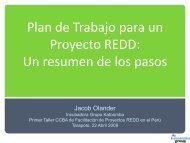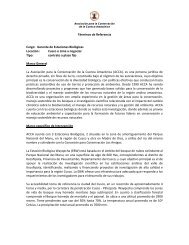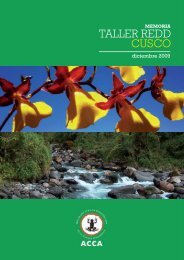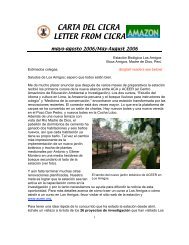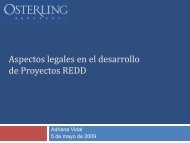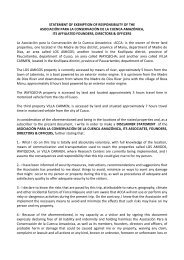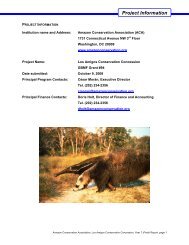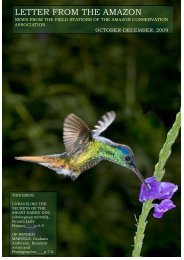Our Goals - Amazon Conservation Association
Our Goals - Amazon Conservation Association
Our Goals - Amazon Conservation Association
Create successful ePaper yourself
Turn your PDF publications into a flip-book with our unique Google optimized e-Paper software.
<strong>Our</strong> <strong>Goals</strong>:<br />
The <strong>Amazon</strong> rainforest is home to 30% of the plant and animal species on Earth. It is also a vital<br />
force shaping the world’s weather and climate patterns. Moreover, 20% of all fresh water on<br />
Earth flows through the basin’s rivers, and these forests are the source of countless foods, fibers,<br />
and potential new medicines to benefit humankind.<br />
Unfortunately, these forests are facing increasing threats from slash and burn agriculture, wildlife<br />
poaching, mining, illegal logging, oil prospecting, and large infrastructure projects. At current<br />
rates, more than half of the <strong>Amazon</strong> rainforest may be destroyed or severely damaged by 2030.<br />
ACA is working together with local communities and partner organizations throughout the<br />
region to protect these precious forests for local inhabitants and future generations. <strong>Our</strong> principal<br />
goals are to:<br />
Goal 1: Protect vital ecosystems. To this end, we support the creation and management of<br />
alternative conservation areas (such as community or civil-society managed conservation<br />
concessions), promote ecosystem-based land use planning, and develop and support the creation<br />
of conservation corridors.<br />
Goal 2: Support communities’ abilities to earn a living while protecting their natural resources.<br />
For example, ACA’s Brazil nut program supports over 500 Brazil nut harvesters to ensure a<br />
sustainable livelihood while protecting over 800,000 acres of rainforest through technical support<br />
and training. We also support conservation-appropriate reforestation, microenterprise, carbon<br />
projects, and community-based ecotourism.<br />
Goal 3: Train the next generation of land stewards. We aim to build the technical capacity of<br />
local citizens for conservation and sustainable management of natural resources, to strengthen<br />
the regional capacity for environmental governance, and to ensure that the scientific results<br />
generated in our research stations reach decision-makers and the public.<br />
<strong>Our</strong> Strategy:<br />
Using cutting-edge science and innovative conservation tools, ACA is creating models for others<br />
to follow. We aim to protect critical forests by creating a network of state, community, and<br />
private lands managed for conservation and sustainable use of resources. We work by forging<br />
ties with governments, nonprofits, and people who depend on the rainforests for their livelihood,<br />
with the goal of saving rare species and habitats and learning from the land. Scientific research<br />
guides our approach, which strives for concrete, measurable achievements. We concentrate our<br />
resources in the field, where they have the largest impact on conservation.<br />
Because long-term conservation depends on active and informed participation by local<br />
stakeholders, we collaborate with people who make a living from the forest and are working to
improve their management of resources. The organization has a long history of working at the<br />
interface of cultural conservation and natural resource conservation in the Andes-<strong>Amazon</strong>. In<br />
this region, cultural diversity and biodiversity resources overlap, and successful conservation<br />
requires action on both fronts. In contrast to the bigger conservation organizations that focus on<br />
parks, we have chosen to work in indigenous and public landscapes with alternative mechanisms.<br />
<strong>Our</strong> Capacity:<br />
ACA was founded in 1999, and since its inception, has been one of the most active and leading<br />
organizations focused on preserving the <strong>Amazon</strong> rainforest. Initially starting with a program to<br />
support Brazil nut harvesting as a method of preventing rainforest deforestation through<br />
economic incentives, ACA has become one of the foremost research and conservation<br />
organizations in the world. In 2001, ACA established the world’s first conservation concession<br />
in Peru, the very first of its kind, which preserves 360,000 acres in the lowland Los Amigos<br />
watershed. The associated Los Amigos Biological station is one of the most productive research<br />
stations in the entire <strong>Amazon</strong>. In 2005, ACA created Wayqecha, the first permanent research<br />
station focused on Andean cloud forest ecology in the entire world. They also helped establish<br />
the first Indigenous <strong>Conservation</strong> Concession in the world with the Queros tribe of Peru.<br />
ACA’s programs are implemented by an experienced staff of tropical ecologists and<br />
conservationists based in Washington, DC and La Paz, Bolivia and through our Peruvian sister<br />
organization, Asociación para la Conservación de la Cuenca Amazónica (ACCA).<br />
Peru's National Council for the Environment (CONAM) granted ACCA its 2004 Award for<br />
Sustainability. The Award for Sustainability is given every year to civil society organizations in<br />
recognition of their efforts and actions for sustainable development in the country. ACCA was<br />
awarded the first place in recognition of its Brazil nut program success in integrating<br />
conservation with social and community development. In 2008, ACCA won an award for<br />
“Environmental Management” from the regional government of Cusco for its work supporting<br />
the Haramba Queros Wachiperi indigenous community in establishing an Ecological Reserve.<br />
The prize is awarded annually in celebration of World Environment Day by Cusco's Natural<br />
Resources and Environmental Management Agency.<br />
Measuring Progress:<br />
ACA’s projects are designed to achieve measurable gains in the following areas:<br />
Conserving forest<br />
Direct protection (conservation concession and land purchases)<br />
Brazil nut forest concessions established<br />
Indigenous conservation areas supported<br />
362,993 acres<br />
876,000 acres<br />
300,000 acres
Training a new generation of conservationists<br />
Field courses hosted at ACA research stations (2002-2009) 58<br />
Scholarships awarded to date (Los Amigos) 120<br />
Scholarships awarded to date (Wayqecha) 22<br />
Researchers and students visiting the Wayqecha since 2000 >1,000<br />
Researcher-days accounted for by Latin Americans (2008) 70%<br />
Grad and undergrad degrees from work at CICRA: 52<br />
Monitoring ecosystem health<br />
Overall species diversity (species recorded to date – Los Amigos) 4,304<br />
Increase in primate along the Los Amigos river (2004 -2007) 67%<br />
Increase in capybara sightings along the Los Amigos River (2004-2007) 131%<br />
Increase in reptile sightings along the Los Amigos River (2004-2007) 108%<br />
Carbon dioxide equivalent stored in forest at Los Amigos<br />
79.4 mill. tons<br />
Miles of trails at Los Amigos established for habitat monitoring 60<br />
Expanding scientific understanding<br />
Research projects hosted to date (Los Amigos) > 160<br />
Research projects hosted to date (Wayqecha) 53<br />
Number of publications in peer-reviewed journals from work at Los Amigos 97<br />
Number of publications in peer-reviewed journals from work at Wayqecha 28<br />
Creating sustainable livelihood opportunities for local people<br />
Families with Brazil nut concessions 420<br />
Members of the Ecoagricultual Sacha Inchi Producers <strong>Association</strong> 30<br />
Brazil nut trees mapped and included in a comprehensive database 120,000<br />
Tree seedlings growing in 6 ACA created communal nurseries in Cusco region 600,000
We know we are being successful if the forests in our target area are protected, communities<br />
have opportunities to thrive through sustainable enterprises, and stakeholders are trained and<br />
motivated to continue to conserve the living landscape.<br />
Some Accomplishments:<br />
1. ACA established the world’s first “conservation concession” - a long-term contractual<br />
partnership between the national government and a non-government actor, whereby the<br />
civil society actor manages state-owned lands for conservation purposes. ACA protects<br />
these 360,000 acres from illegal loggers and slash-and-burn farmers.<br />
2. Since 1999, the Sustainable Brazil Nut Management project has grown to protect over<br />
one million acres of tropical forest through community-based conservation. ACA has<br />
provided technical support to more than 420 Brazil nut harvesting families and helped<br />
obtain voluntary Forest Stewardship Council and organic certifications for 48<br />
concessions.<br />
3. ACA's flagship field station CICRA at Los Amigos extended its run as the most active<br />
research site in the <strong>Amazon</strong> basin. More than 100 researchers representing 39 different<br />
research projects visited the station and seventeen researchers received $75,000 in<br />
scholarships from the station in 2008. More than 450 researchers have studied at Los<br />
Amigos since its inception.<br />
4. Wayqecha, our state-of-the-art biological research station in Peru’s cloud forest hosted 41<br />
active research projects in 2008, and continued to protect 1,450 acres of cloud forest. In<br />
2007-2008, 239 species of orchid were inventoried at Wayqecha, making it likely that<br />
orchid diversity in this area is much higher than predicted.<br />
5. Establishment of the first indigenous conservation concessions managed by the Haramba<br />
Queros Wachiperi nation. ACA provided technical support to the Wachiperi throughout<br />
the process of applying for the concession, designing its management plan, and preparing<br />
the concession application for the Peruvian forest service.<br />
6. Approval by the Peruvian government for the first REDD deal in Peru and continued<br />
management of the project area, the Los Amigos <strong>Conservation</strong> Concession.


